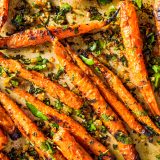In Indian tandoori cooking, much of the flavor is due to the high heat. A searing 900°F, in fact, which tends to send spice and smoke sizzling out the top of the barrel-shaped clay ovens used.
Meats such as chicken and lamb are threaded onto long metal skewers that are lowered inside. They char beautifully, and the meat—almost miraculously, considering the punishing temperatures—emerges tender and juicy.
The secret to not incinerating the meat under such conditions? Yogurt. As part of a marinade, the dairy’s lactic acid gently breaks down the meat’s proteins in such a way that it retains more moisture during cooking without turning mushy. The thick strained yogurt also holds seasonings in place so they don’t run off into the fire as they would with other liquids. And, perhaps most deliciously, the natural sugars in the yogurt caramelize in the high heat, leaving a charred, beautiful crust with a mellow tang and crispy, flavorful bits.
But meat is just the start. Plenty of other foods can benefit from similar treatment. In tikka paneer, skewered cubes of marinated fresh cheese exit the tandoor with a lusciously spiced, caramelized coating.
And in his cookbook, “On Vegetables,” Los Angeles-based chef Jeremy Fox coats young, unpeeled carrots in yogurt seasoned with only salt and pepper, then roasts them in a 500°F oven until blistered and charred. He calls them tandoori carrots and drizzles them with an elaborate curry butter laced with 15 spices and aromatics. For this spice blend, he drew inspiration from vadouvan, a masala (or spice mixture) most strongly associated with the French colonial influence of southeast India’s Puducherry region.
We loved his unique take on roasted vegetables. For our pared-down version, we reached for a spice cabinet shortcut—the blend garam masala. It includes cardamom, black pepper, mustard seeds, coriander, cinnamon, cloves, mace, nutmeg and more. We combined some of the spice mix plus crushed fennel seed and turmeric with full-fat Greek yogurt, whose lower moisture content better facilitates the charring characteristic of tandoori cooking than low-fat conventional yogurt.
While the carrots roasted in a high-heat oven, we prepared a shallot-infused melted butter with more of the spice mix and fresh cilantro and mint. The bitterness of the char and slight acidity from the yogurt complemented the rich spices and mild sweetness of tender carrots. And the fresh herbs lightened a complexly flavored, layered dish that evoked a tandoor, but remained within reach of any home cook.
For Fuller Flavor, Char Your Carrots
A spice-packed coating ensures beautifully caramelized oven-roasted carrots.
Photo: Connie Miller of CB Creatives; Styling: Christine Tobin






